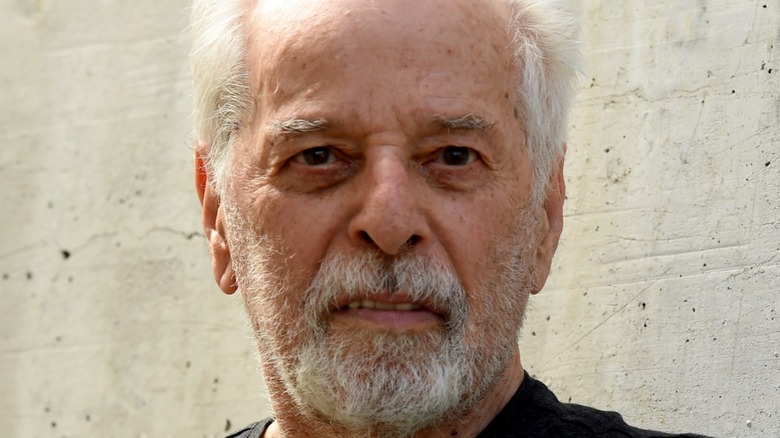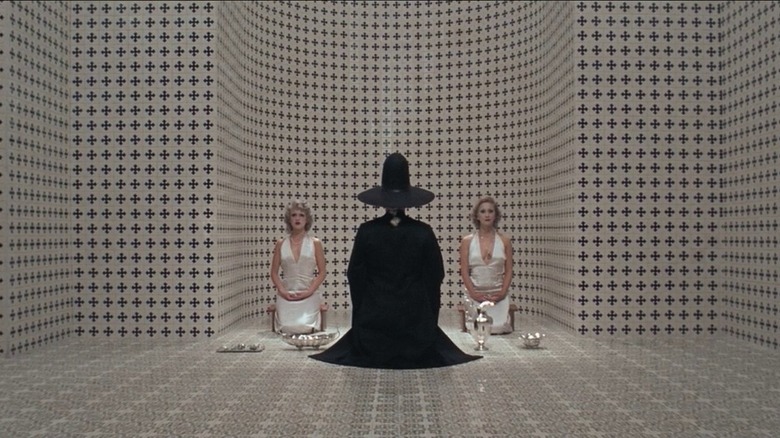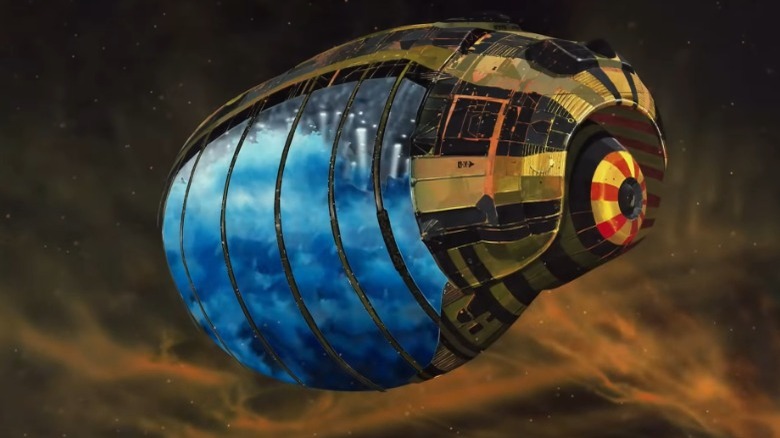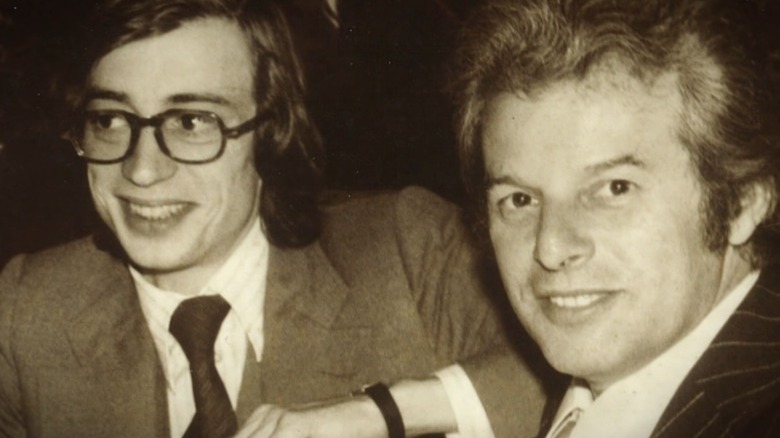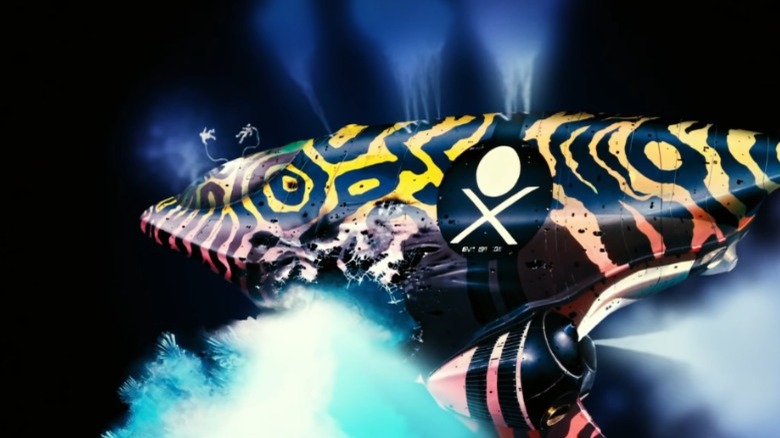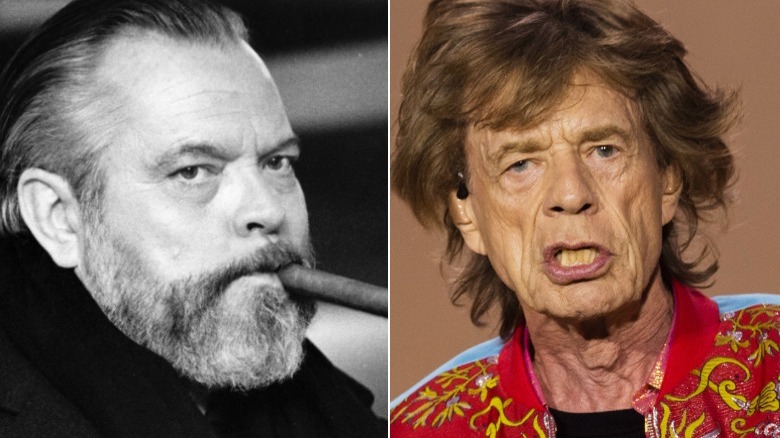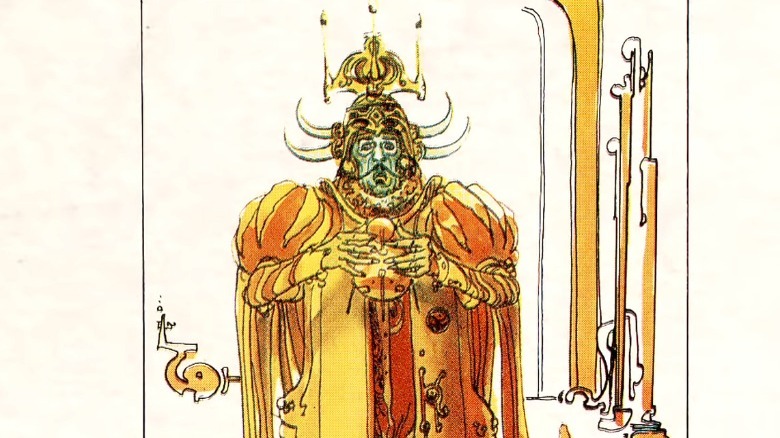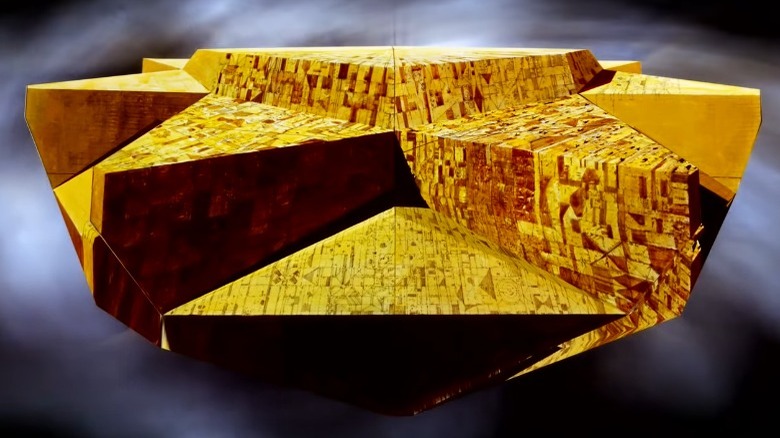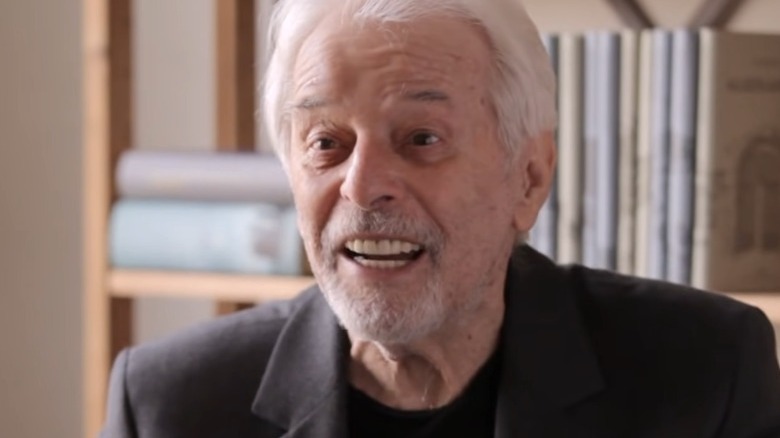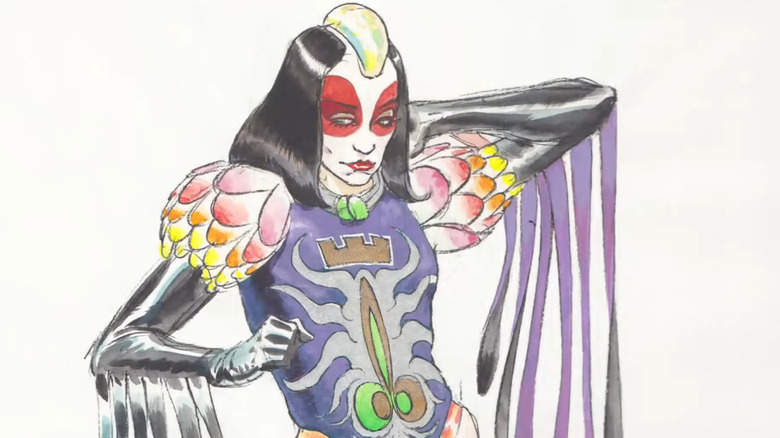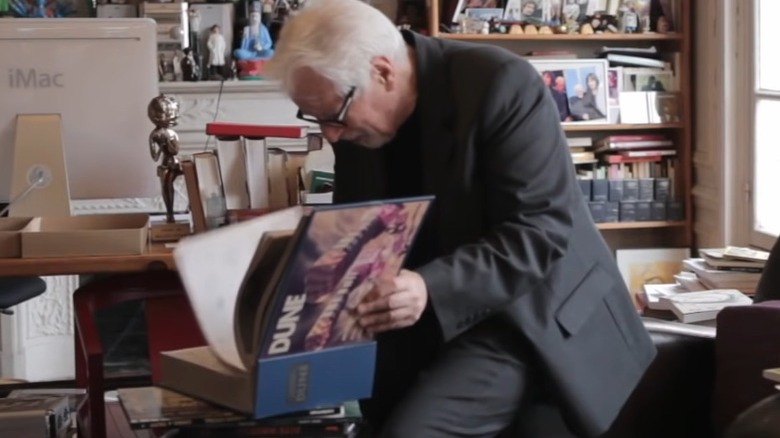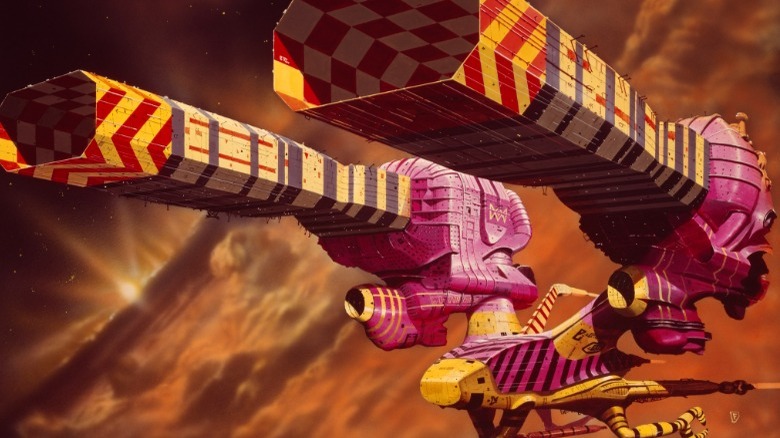Inside Alejandro Jodorowsky's Bizarre Vision For His Never-Filmed Dune Adaptation
"Dune" is the science fiction gift that just keeps giving. When Frank Herbert released the original novel in 1965, it became a staple of the genre. Herbert's sequels continued to expand his imagined universe, and the world of "Dune" has since gone on to inspire multiple adaptations on screens both big and small. While Denis Villeneuve's 2021 "Dune" adaptation (with a sequel on the way) might be the greatest version of the story put to film, and David Lynch's 1984 take remains an odd curiosity, there's another that could have been the most ambitious movie of all time — if it had ever seen the light of day.
Alejandro Jodorowsky, the trippy Chilean "El Topo" filmmaker who is one of those rare directors who have never made a bad movie, set his sights on being the first to adapt "Dune" back in the 1970s. Assembling a formidable group of creatives that included Moebius and H.R. Giger, and a cast that would have included Orson Welles, Mick Jagger and Salvador Dali, it's anyone's guess whether it would have been good — but it certainly would have been worth watching.
If nothing else, Jodorowsky's unsuccessful passion project helped inspire the "Alien" franchise and paved the way for one of the best documentaries about a movie ever made. It could have been a landmark event in sci-fi cinema, but it never even began shooting because of its director's utter unwillingness to compromise on his vision: A 14 hour epic that, he said, would change the course of human history. Yes, seriously. This is a look inside the bizarre, utterly enthralling world of Alejandro Jodorowsky's "Dune."
Alejandro Jodorowsky's artistic background
From the very beginning of the project, Jodorowsky was an unlikely candidate for adapting Herbert's epic novel into an epic movie. While Jodorowsky had certainly proven himself to be a capable director, he didn't have a history of making adaptations or creating mainstream sci-fi action stories anywhere near the scale of "Dune."
Jodorowsky was hailed as the "father of the midnight movie" after "El Topo" debuted in 1970; the film's stunning visuals and stream-of-consciousness storytelling was as unique as it was critically acclaimed. Part cowboy tale and part spiritual journey, the so-called "Mexican acid Western art film" was too bizarre for some audiences, but the unrelenting artistic vision behind it made "El Topo" a classic of arthouse cinema that still populates midnight screenings and retrospectives worldwide.
Three years later, Jodorowsky followed up "El Topo" with "The Holy Mountain," perhaps even more surreal than its predecessor. "Mountain" explores themes of greed, sexuality, and spiritual enlightenment through breathtaking shots and opaque storytelling. Jodorowsky had unleashed his singular style on the world, and in the process earned himself loyal fans and a reputation as one of the most unique auteurs of the '70s.
But as strange as his two best-known films were, they didn't prepare Jodorowsky's admirers for a developing fixation with adapting a series filled with intergalactic travel, imperial power struggles, and desert warriors.
More than a movie
"Dune" is a massive book, and though it's framed by a traditional sci-fi/action plot, the book has a lot to say about economics, warfare, religion, colonialism, and the human spirit. Such themes intrigued Jodorowsky. With "Dune," the director saw an opportunity to once again explore his interests in a cinematic space, but this time with the possibility of reaching a far larger, more mainstream audience and having an even greater effect on his viewers.
As absurd as some of his sentiments at the time may sound, there's simply no way to overstate how important Jodorowsky came to believe his adaptation of Herbert's novel would become.
"'Dune' will be the coming of a god," he said. "Artistical, cinematographical god."
For Jodorowsky, "Dune" represented a personal spiritual journey that might forever alter not just cinematic history, but the entire course of humanity. He referred to the team he recruited to work on the film as his "spiritual warriors" — but as it happened, Jodorowsky's boundless enthusiasm for the project had very little to do with "Dune" itself.
Who reads the book?
"El Topo" and "The Holy Mountain" put Alejandro Jodorowsky on the map of the cinematic world in a big way. Michel Seydoux, a French film producer, was so enamored with the performance of Jodorowsky's movies that he reached out to the director and offered him money for his next project, regardless of what it was going to be (via TV Tropes). Of course, Jodorowksy chose "Dune," but it wasn't exactly an obvious choice. When Seydoux agreed to help Jodorowsky with the adaptation, the director had never actually read the book. At the time, Jodorowsky had only heard a friend describe the plot, but though he'd later get around to reading it, he found that verbal description inspiring enough to begin working on an adaptation.
Jodorowsky's lack of familiarity with the source material in no way dissuaded Seydoux's commitment to the project. According to the BBC, the producer went so far as to rent a castle for Jodorowsky to live in while he worked on his screenplay. Together they imagined creating a film that Jodorowsky said would "change the public's perceptions... change the young minds of all the world" and would be remembered for ages. Ironically, that kind of Earth-shaking ambition runs counter to the entire message of Herbert's "Dune"; of all the things Jodorowsky prioritized, faithfulness in his adaptation wasn't one of them.
Assembling the spiritual warriors
Jodorowsky might have believed that he had the vision to create a film that would change the world, but he also knew that he couldn't create it alone. Michel Seydoux was Jodorowsky's first true-believer and the initial financial backer for "Dune," but once the project was officially underway, the director began seeking a team of collaborators that he called "spiritual warriors" (via BBC). His first task? Recruiting artists that could help bring his vision of "Dune" to life.
Jodorowsky took a unique — and expensive — approach when assembling his artistic team. He assigned different pieces of the film to different renowned artists. Comic book artist Jean "Moebius" Giraud agreed to create a shot-by-shot storyboard for the film that ended up totaling around 3,000 pictures. Dan O'Bannon (who would later write the screenplay for "Alien") signed on to handle the film's plethora of visual effects. Jodorowsky reached out to HR Giger (who would go on to create the look of the "Alien" franchise) to design the Harkonen homeworld, and Chris Foss (who created covers for Isaac Asimov novels) to design the spaceships.
Jodorowsky's team were already established creators, but many of them would go on to have an outsized effect on some of the biggest sci-fi films of all time. Jodorowsky had a knack for building teams, and though "Dune" never got made, some of the artistic work for the project was preserved and later shown off in the documentary "Jodorowsky's Dune."
An unconventional cast
Alejandro Jodorowsky's spiritual warriors weren't just members of the "Dune" artistic team. To bring his grand vision to life, Jodorowsky felt that he needed to put together as impressive a cast as possible. Casting began with a search for the film's lead character, Paul Atreides. Luckily, Jodorowsky had the perfect actor close to home. He cast his nine-year-old son Brontis, and began putting him through grueling martial arts training and intense academic studies that mimicked Paul's education in the film (via DuneInfo). Unfortunately, all the years of training that Jodorowsky asked his son to go through never translated onto the big screen.
The rest of the cast of "Dune," through a series of chance encounters and big promises on behalf of the director, came to include some of the biggest celebrities across multiple industries. Jodorowsky managed to get Mick Jagger to agree to play Feyd-Rutha after running into him at a party, and Orson Welles agreed to play the Baron Harkonnen on the condition that Jodorowsky pay his favorite chef to cook for him every single night during the production (via Tor). Between an extreme streak of luck and a willingness to meet the strange demands of certain actors, Jodorowsky got everyone he wanted to agree to be in the film, but one actor in particular nearly pushed him and the movie over the edge.
The highest paid actor of all time
Despite having his son, Mick Jagger, and Orson Welles, Alejandro Jodorowsky wasn't satisfied with the "Dune" cast. Reflecting on the project for DuneInfo, Jodorowsky wrote that there was one person he wanted more than any other: Salvador Dalí. He wanted the Emperor in "Dune" to be played by the greatest visual artist of his generation, and he was willing to go to extraordinary lengths to make that happen.
As luck would have it, Jodorowsky stayed at the same hotel as Dalí, just as he was beginning to put the "Dune" cast together. The director called Dalí's room, and the two agreed to meet to discuss the film. Dalí proceeded to bail out of one meeting after another, but eventually Jodorowsky saw him at the hotel bar and offered him the role.
Dalí accepted, as long as Jodorowsky meet three demands. First, the Emperor's throne had to look like a toilet made out of the body of two dolphins. Second, instead of reading Jodorowsky's script, Dalí would make up his own dialogue. Third, he'd be paid $100,000 per hour.
What would sound unreasonable to most other directors was a dream come true for Jodorowsky. His financiers weren't willing to pay more than $100,000 to have Dalí in the film, so Jodorowsky cut his part down to a page and a half, intending to film the rest of the Emperor's scene with a plastic Dali replica.
Recruiting musicians
If "Dune" was going to be the masterpiece of cinema that Jodorowsky intended, every aspect of the film needed to be perfect. He had ambitious plans for the film's visuals and cast, and his ideas about the film's score weren't any less grand. According to TV Tropes, Jodorowsky used the same approach for the film's music as he did for its art direction. He wanted the score to be split between Atreides and Harkonnen themes. He planned for Magma to compose the Harkonnen half, while Pink Floyd would handle the Atreides.
Needless to say, Jodorowsky's ideal score never came to be. The film was canceled before a single piece could be composed, but the idea of what might have been still influences "Dune" to this day. In a somewhat subtle nod to Jodorowsky's unfinished work, director Denis Villeneuve and composer Hans Zimmer chose to use the Pink Floyd song "Eclipse" in the trailer for their 2021 adaptation (via Variety). Seeing it all put together, it's easy to understand why Jodorowsky had such a strong inclination for Pink Floyd to be a part of the film.
An overblown budget
In case it isn't already apparent, Jodorowsky has never had a reputation as the most financially conservative film director. When he has had an idea, he completely commits, and has often seemed to believe that one way or another, the money will follow. Ultimately, the expense involved in creating his version of "Dune" would become a key reason the film never got made.
While Michel Seydoux helped provide Jodorowsky with enough money to get the film off the ground, the two of them would need much more if it was going to become a reality. So they went to Hollywood to shop their movie around, at the time asking for a budget of $15 million (via Goggler). That was three times more than the average film budget of the day, so it's unsurprising that they weren't able to find any willing investors.
Even if Seydoux and Jodorowsky could have found more money for "Dune," there was still one other major obstacle to the film's success. Jodorowsky knew just how long his movie would need to be, and like the other aspects of his vision, he wasn't willing to compromise. As Jodorowsky planned it, "Dune" would have been between 10 and 12 hours long, which would have made it difficult for theaters in the late '70s to even show the film; keep in mind, this is long before alternative venues like streaming channels and pay cable came into vogue. While network television did air "miniseries" like Alex Haley's "Roots," Jodorowsky and his unflinching vision weren't exactly the sort of fodder network TV typically would be interested in.
Leaving Frank Herbert behind
If it had been finished, and if theaters had found a way to screen it, would Alejandro Jodorowsky's "Dune" have changed the course of history, cinematic or otherwise? That seems like an unrealistic expectation for any film, but the truth is no one will ever know. One question that might be a bit easier to answer, however, is whether or not fans of Frank Herbert's novel would have been satisfied with Jodorowsky's movie. There, the answer is almost certainly no.
For all its stunning visuals, potentially groundbreaking pieces of music, and impressive cast members, Jodorowsky's "Dune" abandoned much of what made Herbert's novel a beloved sci-fi classic. Jodorowsky has openly admitted that he didn't read the book, and has even said that in creating his movie, "I did not want to respect the novel." He had his own ideas about what "Dune" should be, and they didn't just deviate from the book, they contradicted Herbert's entire message. In a landscape that would roundly condemn David Lynch's "Dune" a decade later, it's hard to imagine an even more offbeat Jodorowsky adaptation would have done any better.
Jodorowsky's version of "Dune" would have ended with Paul Atreides dying, only to be reborn into the planet Arrakis itself. The sentient planet would then become a sort of savior for all humanity, spreading its message throughout the universe. The story fits into Jodorowsky's idea of the film being a source of enlightenment for the real world, but it completely ignores the novel's essential warnings about the danger of proclaiming one being to be a savior for all.
What remains of Dune
Even though "Dune" never secured all its funding, and Alejandro Jodorowsky didn't get to film his cinematic god, the memory of what could have been lives on. Before working on the adaptation, Jodorowsky had already cemented himself as an influential filmmaker, and by bringing together people like Dan O'Bannon and H.R. Giger, the director arguably influenced the creation of other sci-fi classics like "Alien" and "Total Recall."
Outside of its influence on other sci-fi films, Jodorowsky's "Dune" also left behind some physical memorabilia. Back when they were still developing the movie, Jodorowsky and Michel Seydoux put together a number of hardcover volumes collecting the thousands of drawings and storyboards that had been made for the film (via Boing Boing). Fewer than 20 copies were made, but some still exist and occasionally sell at auction for tens of thousands of dollars. Flipping through one of those "Dune" bibles is likely the closest anyone will ever get to actually watching Jodorowsky's vision for the movie.
That said, the second-best way to experience the "Dune" that never was is to watch the documentary "Jodorowsky's Dune." That movie premiered at the 2013 Cannes Film Festival, earning rave reviews. It not only tells the story of all the work done on the film, but also traces the impact it had on the genre and for the first time shows general audiences much of the artwork created before the production fell apart.
21st century problems
Alejandro Jodorowsky's passion for his "Dune" movie inspired some of the greatest artists and actors of the 1970s. Decades after the film failed to get off the ground, Jodorowsky's passion is no less contagious, though some people have certainly walked away wishing they hadn't caught it.
Remember that "Dune" bible that Jodorowsky and his producer Michel Seydoux put together to sell their movie to Hollywood producers? As recently as 2021, one of the remaining copies went up for auction, and it was estimated to sell in the range of $30,000. Collectors everywhere were blown away when the book sold for an order of magnitude higher than they'd expected.
Esquire reported on Spice DAO, a group of cryptocurrency investors and "Dune" fans who collectively bid $3 million on the "Dune" bible. The group had some big plans for their purchase, but those plans almost immediately backfired. Spice DAO hoped to transform the bible into an NFT and produce animated content based on Jodorowsky's plan for his film. Unfortunately for Spice DAO, no one in the group realized that buying the bible didn't equate to buying the rights to intellectual property belonging to Jodorowsky or the Herbert estate. In the end, they essentially threw away $3 million — which in a way feels only appropriate in the aspirational, contradictory, incongruous orbit of Alejandro Jodorowsky's "Dune."
